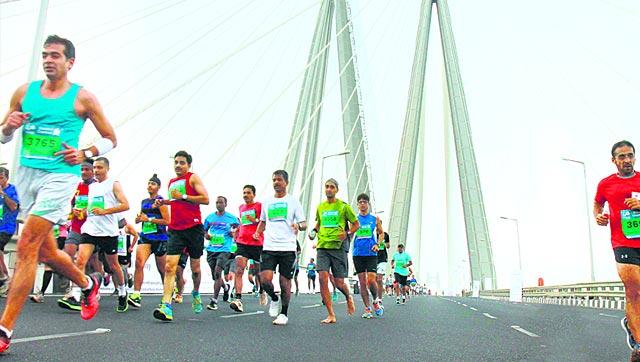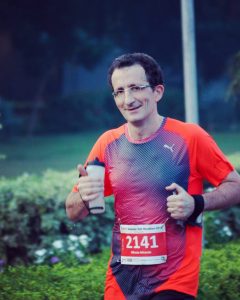“The starting was smooth, soon we were a group of 15 at the head, everything was pretty normal till 33Km when the action started: Tupalee attacked and 7 of us followed him, there were some other movements… but then at 38km I saw my moment and accelerated further, leaving everybody behind. A great victory”
“You know…. Everything was fine, I was feeling great, even I crossed half way 2 min ahead of my target. I thought “I’m killing it!!” But then, at the 33km I started feeling very tired, I don’t know what happened… at 38 I got pains all over… I had to walk from 40 till 41.5, when seeing the finishing line I did the last effort. Buff !!! I missed my target by 10 min…”
These are invented declarations, but they could be perfectly well the words we hear from the winner of a Marathon and one of the amateur runners finishing in the middle of the pack. Both have run the same Marathon, the same distance, but… For the first, the 33km seems “Heaven”: when the action starts and his victory begins to take shape.
The 33rd km mark is “HELL’ for most amateurs runner!
But… really… it has to be like this? Is there no other way? Well, I don’t believe it. We, amateurs, cannot run as fast as the Pros, but we can learn from them and apply to our races the same approach: If a Pro can speed up after 33 km… why we can’t?
Part of the “issue” is in the fuel !!!!!!
It is the unanimous understanding that we extract the Energy from two sources: Fat or Carbohydrates. Fat is more difficult to burn but it gives more energy and the resources are almost unlimited (we have in our body enough fat for several marathons); the Carbs are easier and faster to burn, they generate energy very quick (in a sprint we use practically only Carbs), but the reserves are limited: we have for some 2000 kcal. But there is another factor, the burning of Carbs generate Lactate: the faster they are burned, the more Lactate is produced. When we run easy (they call it aerobic) we burn more fat and less carbs, and we burn the carbs producing less lactate. When we run strong (in the anaerobic zone) then the consumption of carbs increases and we produce more Lactate. The problem with the Lactate is that it chokes the muscles preventing them from working till the blood takes it away (the famous Wall).
With this in view… what the Pro does? Well they know they don’t have enough Carbs for the Full Marathon, so the way to go is to go easy at the starting, working on Fat and preserve the Carbs for the final part. The winner of the marathon will be the runner who reaches the km 33 with more Carbs in his system and less Lactate, because he will be able to increase the pace to a tougher one and maintain it: he has Carbs to burn and space in his body to store the Lactate.
What happens with the average amateur marathoner? Carried away by the enthusiasm or scared of not meeting the target…. He/she goes tough from the starting, perhaps not very tiresome from his/her point of view, but tough enough so as not allow the body to burn Fat, the Carbs get consumed from the first km at a higher rate… by the km 33 there is almost no Carbs left and a lot of Lactate in the system, “the rest is History” as they say….
A smart reader may have noticed by now that no reference has been made to specific pace… deliberately the terms “easy” and “tough” has been used because that is the key factor !! “easy pace” for a professional will be 3:10, and for an amateur can be 5:00, or 6:00, or 7:00 !!! But that does not matter, the concept applies to both.
“OK, fine, but… how we learn to burn more Fat and less Carbs?” In my place they say that “ducks learn to swim by swimming!” Your body will learn to burn Fat if you let it do it, and for that you need to do the long runs easy, really easy: easy in your legs, easy in your breathing, easy in your heart, easy in your mind… at no moment during the run the thought of “I don’t know if I will finish this run” should cross your mind. The Heart rate is a good indicator of this. Here is an article on Training by Heart Rate and improving upon your endurance. Combined with the right Tempos and Intervals, little by little you will experience that you can handle a faster pace while still keeping the easiness…
The same concept applies to the Race Day. The first part of the race has to be done easy, with the feeling of saving energy, so that later it is possible to increase the pace: “negative splits is not a matter of going faster at the end, but of going slower at the beginning”. Or if not possible to increase, at least it will be possible to maintain it, preventing the collapse towards the end of the race which many runners go through and finishing it strong and with a happy mood.
by Alfredo Miranda
Warmly known as Alfie by runners in the NCR Region, he is a mentor and a guide, par excellence, to many fledgling and mature runners. A super marathoner himself, he helps runners with their running plans for various events and most important always keeps their morale high up!
Alfie lives by the philosophy – The Killing is yet to come, you will see how well you push yourself…
He is reachable at [email protected].



11 comments
I was in need of it…thanks Alfredo n wellthy.fit
🙂
Very useful piece of information
I feel it’s true
Thanks Guru jee !
Excellent write-up… Thanks
Very well written, simplified it like a professor!
Very well put Alfie! Yup will remember these tips in SCMM this year.
I too need this advice for deciding my first full marathon strategy. Thanks
I v tkn prt in 8 half marathon.
Started in ADHM 14 wid 2 hrs 57 mts.
In Dec. 16 time was 2 hrs 20 mts.
Jan 17, 2 hrs 28 mts.
I want 2 participate in full marathon.
How can I prepare.
I m doctor by profession.
No holiday even on Sunday.
Age is >65 yrs.
Dir Sir,
It requires time, dedication and proper planning. I’ll be in touch in email.
All the best !!
Greaaaat advice, must follow especially for a first timer like me. Thanks for very useful write-up. Please need advice for running first time full Marathon. Till now ran 5 HM